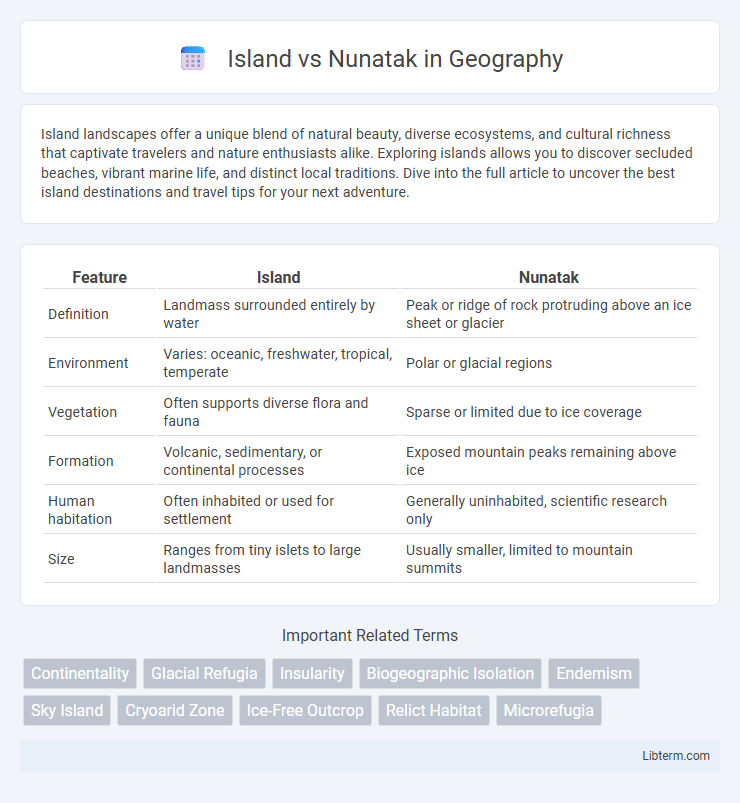Island landscapes offer a unique blend of natural beauty, diverse ecosystems, and cultural richness that captivate travelers and nature enthusiasts alike. Exploring islands allows you to discover secluded beaches, vibrant marine life, and distinct local traditions. Dive into the full article to uncover the best island destinations and travel tips for your next adventure.
Table of Comparison
| Feature | Island | Nunatak |
|---|---|---|
| Definition | Landmass surrounded entirely by water | Peak or ridge of rock protruding above an ice sheet or glacier |
| Environment | Varies: oceanic, freshwater, tropical, temperate | Polar or glacial regions |
| Vegetation | Often supports diverse flora and fauna | Sparse or limited due to ice coverage |
| Formation | Volcanic, sedimentary, or continental processes | Exposed mountain peaks remaining above ice |
| Human habitation | Often inhabited or used for settlement | Generally uninhabited, scientific research only |
| Size | Ranges from tiny islets to large landmasses | Usually smaller, limited to mountain summits |
Definition of Island and Nunatak
An island is a landmass completely surrounded by water, typically smaller than a continent and rising above the sea level, often supporting diverse ecosystems. A nunatak is a mountain peak or rocky element that protrudes above an ice field or glacier, remaining exposed amidst ice-covered regions. Both features represent distinct geological formations but differ fundamentally in their environmental contexts and interactions with surrounding elements.
Key Geological Differences
Islands are landmasses surrounded entirely by water and often formed by volcanic activity, tectonic uplift, or sediment accumulation, whereas nunataks are exposed, often rocky peaks protruding above glaciers or ice sheets, primarily shaped by glacial erosion. Geological composition of islands can vary widely, including sedimentary, igneous, or metamorphic rocks, while nunataks typically consist of resistant bedrock that withstands glacial abrasion. The formation timeline differs as islands can arise over millions of years due to tectonics or volcanism, whereas nunataks reveal longstanding geological structures temporarily uncovered during glacial retreats.
Formation Processes
Islands form primarily through volcanic activity, sediment accumulation, or coral reef growth surrounded by water, creating standalone land masses above sea level. Nunataks emerge as exposed peaks of mountains or rock that protrude through glacial ice sheets or glaciers, shaped by glacial erosion and ice dynamics rather than water-based processes. The key distinction lies in islands developing in aquatic environments, while nunataks result from glacial retreat revealing underlying bedrock.
Ecological Significance
Islands often harbor unique ecosystems with high biodiversity due to their isolation, supporting endemic species and complex ecological networks. Nunataks, exposed peaks surrounded by glaciers, serve as critical refuges for specialized cold-adapted flora and fauna, maintaining genetic diversity in harsh polar environments. Both landforms contribute to ecological resilience by providing habitats that enable species survival amid climate change and environmental shifts.
Climate and Weather Conditions
Islands typically experience maritime climates with moderate temperatures, high humidity, and frequent precipitation due to their surrounding water bodies, which influence weather patterns and temperature stability. Nunataks, exposed rocky peaks surrounded by ice sheets or glaciers, endure extreme polar climates characterized by low temperatures, minimal precipitation, and strong winds, resulting in hostile and dry weather conditions. These contrasting environments directly affect local ecosystems and the types of flora and fauna that can survive in each setting.
Flora and Fauna Diversity
Islands typically support richer flora and fauna diversity compared to nunataks due to more stable soil development and milder microclimates, allowing various plant species and animal communities to establish and thrive. Nunataks, isolated rocky peaks surrounded by glaciers, have limited soil and harsher environmental conditions, resulting in sparse vegetation dominated by lichens, mosses, and a few cold-adapted invertebrates. The isolation of nunataks restricts species colonization, while islands often serve as biodiversity hotspots with complex ecosystems influenced by surrounding marine environments.
Human Exploration and Settlement
Islands often offer more accessible environments for human exploration and settlement due to their larger size, diverse ecosystems, and availability of freshwater resources. Nunataks, being isolated mountain peaks protruding through ice sheets, present extreme challenges such as harsh climates and limited habitable space, making permanent human settlement rare. Scientific expeditions on nunataks primarily focus on geological and climatic research, whereas islands support long-term communities and economic activities.
Role in Glaciology and Geography
Islands serve as prominent landmasses surrounded by water, influencing ocean currents and ecosystems, whereas nunataks are exposed rocky peaks protruding above ice sheets or glaciers, crucial for studying ice thickness and glacial dynamics. Nunataks provide vital reference points for understanding glacier movement and historical ice coverage, offering insights into past climate conditions. Islands contribute to geographic biodiversity and act as natural laboratories for studying marine and terrestrial interactions, while nunataks help glaciologists map subglacial topography and observe isolated ecological niches within ice-covered regions.
Examples from Around the World
Islands such as Greenland and Madagascar are landmasses entirely surrounded by water, while nunataks like Mount Whymper in Canada and the Allgau Alps in Germany are exposed rocky peaks protruding through ice sheets or glaciers. Islands serve as habitats with diverse ecosystems and often support human populations, whereas nunataks provide critical refuges for flora and fauna within glacial environments. Both geological features are key to understanding Earth's climatic history and biodiversity distribution in polar and alpine regions.
Conservation Challenges and Efforts
Islands and nunataks both face unique conservation challenges due to their isolated ecosystems and limited biodiversity. Islands often struggle with invasive species, habitat destruction, and climate change impacts, while nunataks, isolated mountain peaks surrounded by glaciers, confront threats from glacial melting and limited refuge for flora and fauna. Conservation efforts include invasive species control on islands, habitat restoration, and climate monitoring on nunataks to preserve endemic species and maintain ecological balance.
Island Infographic

 libterm.com
libterm.com